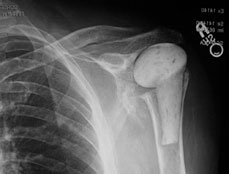Early follow-up reveals high complication rate with reverse shoulder arthroplasty
Reports show that many reverse shoulder procedures are performed in patients younger than 70 years.
SAN FRANCISCO — While a search of the American Board of Orthopedic Surgery part 2 database reveals a gradual increase in the number of reverse shoulder arthroplasties performed, investigators of a recently presented study also found a high complication rate with the procedure and that a third of cases were performed on patients younger than recommended guidelines.
“The rate of reverse arthroplasty is increasing,” Stephen C. Weber, MD, said during his presentation at the American Academy of Orthopaedic Surgeons 2012 Annual Meeting. “One-third are performed under Dr. Charles A. Rockwood, Jr.’s recommended age [limit of 70 years]. The 27% complication rate is reasonable, but high even with short-term follow-up.”
Weber and colleagues studied the 6-month case lists of part 2 certification candidates submitted to the American Board of Orthopedic Surgery between 1999 and 2010, and identified 320 cases of reverse shoulder arthroplasty with a mean 10.1 weeks follow-up. The first reverse shoulder arthroplasty case was reported in the database in 2005, Weber noted, and the procedure represented 0.17% of all cases reported in 2009. The search also revealed that reverse procedures represented 2.6% of cases performed by shoulder fellowship-trained surgeons.

Stephen C. Weber
Complications reflect other reports

Stephen C. Weber
Overall, the investigators discovered that one-third of the reverse shoulder arthroplasties reported were performed in patients younger than the recommendation of 70 years.
“The patient ages were young,” Weber said. “The youngest male patient was 34 years and the youngest female patient was 50 years, [which is] certainly on the young side.”

Infected reverse arthroplasty status post placement of antibiotic spacer and debridement is shown. Loss of bone stock secondary to infection and large bone resection can make revision challenging, Weber noted.
Image: Weber SC
The researchers found a 27% complication rate with the procedure and found no significant difference in the complication rates between fellowship-trained and general orthopedic surgeons. Among the complications cited included intraoperative fracture (3.6%), perioperative dislocation (2.3%) and infection (2.12%).
“The reverse prosthesis continues to be a viable option, and the complication rates were not catastrophically different from what has been previously reported,” Weber said. “Many of these patients probably had few other options.”
‘Bothersome’ findings
Limitations of the study included the use of surgeon self-reports and short follow-up, which Weber said would not document cases of loosening, late dislocations or notching.
He highlighted the young age of patients as cause for concern.
“The age is worrisome and given the current survivorship data, this is bothersome to me because there are not great options for the failed reverse [shoulder],” Weber said. “Fellowship training did not improve patient selection or results, if you think younger age is bad, and why is that? Well, many residents are getting exposed to reverses in their training and so may have been exposed to this new technology. Recognize that most of the candidates were doing four to six reverses a year and may not have been early on their learning curve. The truth of the matter is that a lot of the candidates are savvy in that they are not going to do a case [in which] they are worried about the outcome during their reporting period.” – by Gina Brockenbrough, MA
Reference:
- Weber SC, Martin DR, Harrast JJ. Reverse shoulder replacement: Incidence rates, complications and outcomes as reported by ABOS part 2 candidates. Paper #430. Presented at the American Academy of Orthopaedic Surgeons 2012 Annual Meeting. Feb. 7-11. San Francisco.
For more information:
- Stephen C. Weber, MD, can be reached at Sacramento Knee and Sports Medicine, 2801 K Street, Sacramento, CA 95816; email: webersc@earthlink.net.
Disclosure:
- Weber has no relevant financial disclosures.

